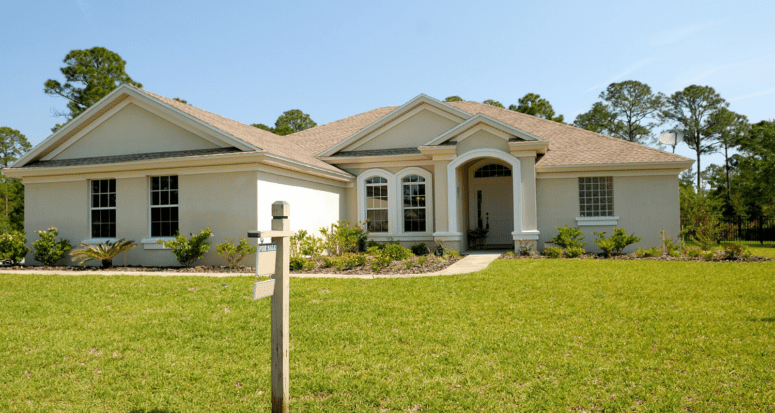How to Find a Low Down Payment Option That Works for You
- Published on
- 5 min read
-
 Kim Dinan Contributing AuthorClose
Kim Dinan Contributing AuthorClose Kim Dinan Contributing Author
Kim Dinan Contributing AuthorKim Dinan is a writer, journalist and author. She's the outdoor news editor at Blue Ridge Outdoors and writes regularly for her local paper in Asheville, NC, covering everything from the necessity of home inspections to trends in the local economy. Kim is also the author of "The Yellow Envelope," a memoir about the time she sold her house and traveled around the globe.
Many would-be homebuyers become overwhelmed at the thought of saving up 20% to put down on a home (that’s $40,000 on a $200,000 home — not including closing costs.) Although a 20% down payment has become the gold standard, it’s pretty rare for buyers to come to the table with 20% down. In fact, the National Association of Realtors reports that in 2019, first-time buyers who financed their home typically financed 94% with a 6% down payment, while repeat buyers financed at 84% with a 16% down payment.
“The current minimum down is 3%, often limited to first-time buyers with income limits,” says Lou Barnes, a Senior Mortgage Loan Officer with Premier Mortgage Group who has over 30 years of experience in the industry. “But 5% down is available to anyone.”
Let’s take a look at some of the low-down-payment loans available so that you can find a low-money-down option that works for you.
One note: Lenders have been increasing loan standards by imposing mortgage loan overlays in the wake of the coronavirus pandemic, additional standards above and beyond those required by the government. Although these are the minimum down payment requirements outlined in the various programs mentioned, individual lenders can and do require higher credit scores or bigger down payments when the loan environment is riskier. Talk to your real estate agent and your loan officer about your options right now.

Why do you need a down payment?
As a homebuyer, you may be wondering what the point of a down payment is, anyway. “There are a couple of reasons lenders require a down payment,” says Melanie Hunt, a top-selling real estate agent in Fort Worth, Texas. “The lender wants to know that you can save, because having savings is important in terms of the fact that you’ll be able to keep the house. You used to be required to have four months of house payments in savings to close on a loan because lenders want to know that you’ve learned to commit money to the house and you’ve got skin in the game,” Hunt explains.
When the Great Recession hit the Fort Worth area in 2008, buyers who bought with no money down were the first to walk away from their homes. “They had no skin in it; They didn’t lose $10,000 or $15,000,” Hunt says.
A down payment then, is an assurance for the lender that the buyer will me more likely to do everything possible to protect their investment.
What happens if you can’t put 20% down?
“As the down payment falls below 20% toward zero, all loan types have add-on costs to cover larger rates of default and foreclosure,” says Barnes.
“FHA loans require a Mortgage Insurance Premium, MIP, a one-time lump-sum financed by FHA, and a monthly fee.”
On a conventional loan, says Barnes, you’ll likely have to pay private mortgage insurance (PMI) when you put down less than 20%. PMI is an insurance policy that compensates lenders in case you default on your loan. PMI will typically cost you about 0.5% to 1% of the total loan costs, so on a $200,000 mortgage you could end up paying as much as $2,000 per year in PMI.
The good news, says Barnes, is that “because of low defaults, the cost of PMI is the lowest in its history.”
You can get rid of PMI with some loans once you’ve accrued enough equity, but if you don’t have at least a 10% down payment, you could end up paying PMI for the lifetime of the loan unless you refinance.
How much do you need to put down to get a good deal?
Many homebuyers want to know how much money they need to put down in order to avoid a high interest rate or expensive PMI. “As the down payment approaches zero on any loan, add-on costs are high, often huge,” says Barnes. “It’s often advisable to wait and save until 3% down is available. Having 5% down will make buying much cheaper, and with 10% down, the add-on is hardly noticeable for those with high credit scores.”
The same advice goes for those with poor credit. If a borrower has a 740 credit score and can put 5% down, the cost of mortgage insurance collapses below 0.5% per year, says Barnes. “Both PMI and interest rates increase with each 20-point drop in FICO scores below 740,” he says. “Below 680, conventional loans are too expensive. FHA and VA loans are still feasible to 620 and below, but the cost is awful.”

Low-money-down loan programs
FHA loans
FHA loans are loans insured by the Federal Housing Administration. Because the loans are insured by FHA, the lender can offer the borrower a better deal. FHA loans offer low down payments, low closing costs — and it’s easy to qualify for an FHA loan, even with bad credit.
Parameters of FHA loans
Credit score
In 2020, borrowers with a FICO score of 580 or higher qualify for an FHA loan with a 3.5% down payment. Those with a FICO score lower than 580 may still be able to get an FHA loan, but a 10% down payment is required.
Income
According to SFgate, the FHA does not have a minimum income requirement. However, it does make sure that prospective buyers can afford their mortgage by requiring them to provide proof of a steady income for the last three years.
Loan limits
The maximum loan amount that the FHA will insure in 2020 is $331,760 for single-family home loans in 80% of the country. In the other 20% of the country where housing costs are higher, the maximum loan amount for a single-family home is $765,600. Check the FHA mortgage limits in your area to be sure.
Geographic limits
None.
How can funds be used?
FHA loan funds can be used to purchase a single-family home, multifamily properties up to four units, row-houses, and individual condos. FHA also provides financing for mobile homes and factory-built homes. The FHA has two loan products for mobile-home owners — one for those who own the land that the home is on and another for mobile homes that are, or will be, located in mobile-home parks.
Borrowers can also finance energy efficiency improvements with their FHA mortgage. The improvements include energy-saving equipment and active and passive solar and wind technologies, and they must be based on recommendations performed by a qualified home-energy assessor.
Additionally, the FHA 203(k) program allows homebuyers to finance up to $35,000 into their mortgage to rehab or repair their single-family properties.
Downsides to FHA loans
Barnes warns that the mortgage insurance premium (MIP) is the highest in FHA history, a fact that is driving better-qualified borrowers to other loan types. “The weaker are remaining with FHA, increasing FHA risk and MIP cost — it’s a bad spiral,” he says.
FHA homes must also pass inspection by an FHA-certified appraiser, and they must be move-in ready on the day the deal closes. These tighter-than-traditional-loan regulations may make it hard for the property you’d like to buy to qualify for funding.

Fannie Mae HomeReady loan
Fannie Mae HomeReady loans are loans created for people who can’t afford a large down payment, first-time homebuyers, or homeowners looking for more affordable refinancing options. The down payment on a Fannie Mae HomeReady loan is as low as 3%.
Aside from the low down payment, another big bonus of the Fannie Mae HomeReady loan is that borrowers can drop their mortgage insurance (PMI) once the equity in their home reaches 20%.
Parameters of Fannie Mae HomeReady loans
Credit score
Buyers must have a credit score of 620 or higher.
Income
Income limits vary depending on where the borrower lives, but borrowers can make no more than 80% of the area median income.
For example, in Seattle, Washington, the area median income is $101,700, so the HomeReady income limit is $81,360. In St. Louis, Missouri, the area median income is $81,200, making the HomeReady income limit $64,960.
To find the limits in your area, check out the Fannie Mae HomeReady Income Eligibility Lookup tool.
Loan limits
The maximum loan amount for 2020 is $510,400 for a single-family home in the contiguous United States, increasing to $981,700 for a four-unit property. In high-cost areas of the country, the maximum loan amount is $765,600 for a single-family home, increasing to $1,472,550 for a four-unit property.
Geographic limits
None.
How can funds be used?
Funds can be used to purchase single-family homes of one to four units, condos, townhomes, and planned unit developments. Manufactured housing mortgages are allowed with a loan-to-value ratio up to 95%. HomeReady also offers flexibility for extended-family households, such as permitting rental income from an ancillary dwelling unit or boarder.
Other requirements
When all occupying borrowers on a HomeReady loan are first-time buyers, at least one borrower must complete the Framework online education course.
Downsides to Fannie Mae HomeReady loans
At 620, the minimum credit score for a Fannie Mae HomeReady loan is higher than the minimum credit score for an FHA loan (580), meaning some buyers won’t be able to qualify for this program. Because the debt-to-income ratio for homebuyers can be no more than 50%, those carrying a hefty debt load will not be eligible for this loan.

Conventional loan with 3% down
A conventional loan is a home loan that is not insured by any of the federal mortgage program sponsors (think: FHA, VA, and USDA loans). According to SFGate, conventional loans require a FICO score of 680 or higher and a minimum of 5% down. However, for qualified borrowers, it is possible to snag a conventional loan with only 3% down. These are called conventional 97 loans.
Parameters of a conventional loan with 3% down
Credit score
The minimum credit score is 620. However, many lenders will require a higher credit score.
Income
There are no income limits to a conventional 97% loan.
Loan limits
The loan amount is required to be at or below $510,400, and at least one buyer should not have owned a home in the last three years.
Geographic limits
None.
How can funds be used?
Conventional 97 loans can be used to purchase 1-unit principal residences, including eligible condos, co-ops, planned development units, and manufactured housing.
Other requirements
When all occupying borrowers on a conventional 97% loan are first-time buyers, at least one borrower must complete the Framework online education course.
Downsides to putting 3% down with a conventional loan
As with any low-money-down loan, the less you put down on a home, the higher your interest rate will be. According to My Mortgage Insider, mortgage rates for the 3% down program are based on standard Fannie Mae rates, plus a slight rate increase (about one-eighth to one-quarter of one percentage point higher than rates for borrowers putting 5% to 10% down).

Other options
In addition to these low-money-down loan programs, Hunt advises buyers to investigate local programs that may reduce or even eliminate down payments or pay closing costs. “Contact the housing authority in the city or county you live in,” she says, “and get a list of programs that can assist local homebuyers.”
So there you have it: Even if you don’t have the cash for a 20% down payment, one of these low-money-down loan options may just work for you.
Header Image Source: (Pixabay / Pexels)
